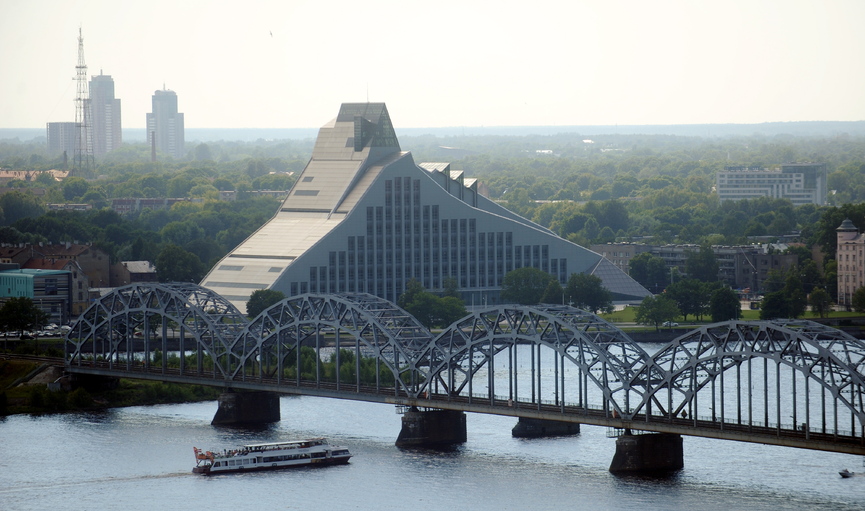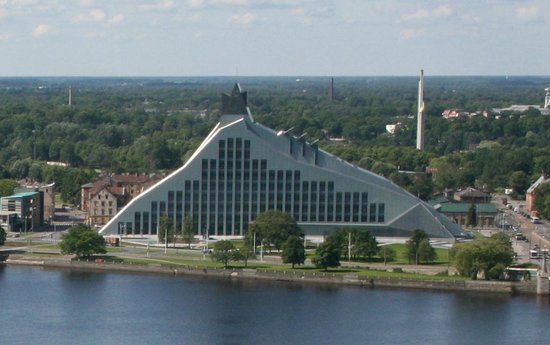National Library of Latvia
The National Library of Latvia, also known as the Castle of Light, is a library and cultural institution on the left bank of the Daugava river, Riga.
The National Library was originally formed in 1919, shortly after Latvia was proclaimed an independent country at the end of the First World War. The growth of the library over the decades meant that the stock was divided between various locations across the city of Riga.
In 2008, construction of the new library began, designed by the architect Gunnar Birkerts, who had been given the commission back in 1989.
Birkerts took as inspiration for his design, the idea of a crystal mountain, which in Latvian folklore symbolises the height of achievement and the commitment required to attain it. The ‘castle of light’ is an evocative metaphor in Latvian culture for lost wisdom that will be regained once the population is able to overcome occupation and war.
The building is 68 m high, 170 m long, and takes the form of an asymmetric triangular slab topped with a jagged crown. It is a concrete structure clad with glass, with steel-framed higher floors. Its glassy slopes mirror the spires that shape the skyline of Riga’s Old Town across the river.
Natural light floods down through three skylights into a large 8-storey atrium below the glass crown apex.
The project was completed in 2014 to its 193 million euro budget, and is used for a variety of cultural purposes, including conferences and conventions. A prominent landmark on Riga’s skyline, it is considered one of Latvia’s greatest cultural projects of the 21st century.
[edit] Related articles on Designing Buildings Wiki
- Cathedral of Brasilia.
- Elbphilharmonie Hamburg.
- Kunsthaus Graz.
- Sage Gateshead.
- Tempe Municipal Building.
- Tianjin Binhai Library.
- Unusual building design of the week.
- Western City Gate, Belgrade.
[edit] External resources
- National Library - Official site
Featured articles and news
Latest Build UK Building Safety Regime explainer published
Key elements in one short, now updated document.
UKGBC launch the UK Climate Resilience Roadmap
First guidance of its kind on direct climate impacts for the built environment and how it can adapt.
CLC Health, Safety and Wellbeing Strategy 2025
Launched by the Minister for Industry to look at fatalities on site, improving mental health and other issues.
One of the most impressive Victorian architects. Book review.
Common Assessment Standard now with building safety
New CAS update now includes mandatory building safety questions.
RTPI leader to become new CIOB Chief Executive Officer
Dr Victoria Hills MRTPI, FICE to take over after Caroline Gumble’s departure.
Social and affordable housing, a long term plan for delivery
The “Delivering a Decade of Renewal for Social and Affordable Housing” strategy sets out future path.
A change to adoptive architecture
Effects of global weather warming on architectural detailing, material choice and human interaction.
The proposed publicly owned and backed subsidiary of Homes England, to facilitate new homes.
How big is the problem and what can we do to mitigate the effects?
Overheating guidance and tools for building designers
A number of cool guides to help with the heat.
The UK's Modern Industrial Strategy: A 10 year plan
Previous consultation criticism, current key elements and general support with some persisting reservations.
Building Safety Regulator reforms
New roles, new staff and a new fast track service pave the way for a single construction regulator.
Architectural Technologist CPDs and Communications
CIAT CPD… and how you can do it!
Cooling centres and cool spaces
Managing extreme heat in cities by directing the public to places for heat stress relief and water sources.
Winter gardens: A brief history and warm variations
Extending the season with glass in different forms and terms.
Restoring Great Yarmouth's Winter Gardens
Transforming one of the least sustainable constructions imaginable.
























